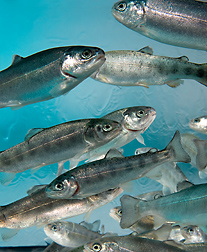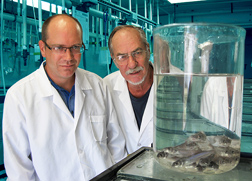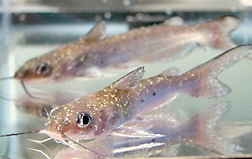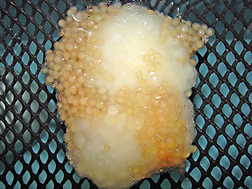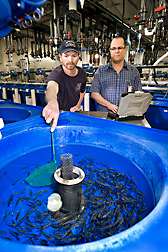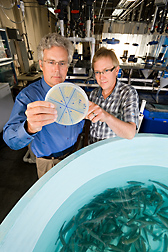Keeping Aquaculture Fish Healthy
Keeping aquatic animals healthy in tanks, ponds, and cages is a critical aspect of fish and shellfish farming.
ARS scientists are researching various aspects of fish health, including genetic-based resistance to pathogens, treatments to cure diseases, and vaccines to prevent them.
Cold-water Disease Targeted
At the National Center for Cool and Cold Water Aquaculture (NCCCWA) in Leetown, West Virginia, one of the diseases researchers are investigating is bacterial cold-water disease, caused by the bacterium Flavobacterium psychrophilum. This disease is a longstanding problem in trout aquaculture, and methods for its control are limited. The disease was first described in 1948, and it occurs in salmon, trout, and a few other species. It often arises at low temperatures, and infected fish may display a range of clinical signs, including large, open lesions on the tail area as well as systemic infection. F. psychrophilum is considered one of the most important salmonid pathogens worldwide because of the large number of fish deaths caused by infection and the resulting economic impact among commercial aquaculture producers.
In 2003, NCCCWA molecular biologist Greg Wiens and microbiologist Tim Welch began talking to industry trout producers about their issues and concerns, and cold-water disease came up most often. “We worked closely with industry partner Scott LaPatra at Clear Springs Foods in Idaho, and obtained F. psychrophilum strains from his facility,” says Wiens. “We sequenced the genome of one strain and used this information to design PCR [polymerase chain reaction] assays to measure genome variation. Now we can better distinguish between isolates, and we are trying to determine the impact these different variants have on trout disease resistance.”
Fish can be infected simultaneously with multiple strains—up to three pathogen strains were found in a single fish. Studies are under way to test the responses of fish when exposed to F. psychrophilum variants.
To mitigate the pathogen’s impact, Wiens has been working since 2005 to selectively breed rainbow trout for improved resistance to bacterial cold-water disease. “It is a large project involving many scientists and personnel at our facility,” including geneticist Tim Leeds, computational biologist Roger Vallejo, and Jeff Silverstein, who is now the national program leader for ARS’s national program on aquaculture.
“After two generations of selection, we found there was a 45-percent improvement in survivability of the resistant trout,” says Wiens. “Small-scale field trials are currently under way in Utah and Idaho to determine how well our fish perform on farms when they are subjected to natural challenge with the pathogen. A larger field trial is planned for 2011.” These resistant lines will offer breeders a genetic resource for improving disease resistance in commercial populations.
Wiens and his colleagues also noticed something quite interesting about the resistant fish: They have larger spleens. The researchers have now found that spleen size is highly heritable and that there is a genetic correlation with bacterial cold-water disease resistance. Understanding the relationship between resistance and spleen size may provide clues to help researchers select for resistance more rapidly and may reveal important insights about the immune response generally. They are now trying to map the rainbow trout genes affecting disease resistance and variation in spleen size. These genetic studies are being conducted by geneticist Yniv Palti and center director Caird Rexroad III.
|
|
“Ichy” Fish
Dave Straus in Stuttgart, Arkansas, is researching treatments to control disease on catfish, specifically Ich and fungi. “Ich” is short for Ichthyophthirius multifiliis, a protozoan parasite that at maturity appears as white spots on infected fish—the scourge of anyone who has owned an aquarium. Because catfish don’t have scales, they are particularly vulnerable to this parasite.
“Ich is considered the most prevalent parasite worldwide in ornamental fish, baitfish, and food fish,” says Straus, an aquatic toxicologist at the Harry K. Dupree Stuttgart National Aquaculture Research Center. “It is less common in U.S. aquaculture because of management techniques, but when it occurs, it can kill all the fish in a pond or raceway. Based on results of a 2003 survey, it was calculated that Ich was directly responsible for $1.2 million in losses to the catfish industry.”
The freshwater fungus Saprolegnia is another major pathogen in fish culture, killing eggs and invading wounds and lesions on juvenile and adult fish.
One effective treatment for Ich on fish and fungus on eggs is copper sulfate. Straus’s lab conducted research to determine effective doses for each use. “Copper sulfate is the only practical treatment to control Ich in catfish ponds that average about 10 acres in area. It is easy to use, effective, inexpensive, and safe to the person using it,” says Straus. “Approved treatments for fungus on eggs—formalin and hydrogen peroxide—are much more expensive; both compounds are hazardous, and there are human safety concerns as well as storage precautions.”
During the life cycle of Ich, only the free-swimming stage is susceptible to treatments. Once Ich attaches to the fish, it burrows under the skin, and copper sulfate treatments are rendered ineffective.
“Copper sulfate is not approved by the U.S. Food and Drug Administration (FDA) for therapeutic use in aquaculture, but regulatory action has been deferred pending the outcome of ongoing research at our lab,” says Straus. “Copper sulfate is approved by the U.S. Environmental Protection Agency as an algicide and molluscicide. Fish farmers use copper sulfate to control cyanobacteria that cause off-flavor in fish and to control snails that transmit parasitic flatworms to fish.”
|
|
Straus is working with corporate sponsor Freeport-McMoRan Copper and Gold of Phoenix, Arizona, to obtain FDA approval to use copper sulfate as a treatment for Ich in earthen production ponds and as a fungicide on eggs in catfish hatcheries. Research has recently been completed for all technical sections for both label claims—control of Ich on catfish and fungus on catfish eggs.
“All technical sections are complete for the approval for Ich in catfish except for the environmental safety. We plan to resubmit the environmental assessment to the FDA by the end of the year with the additional information the agency requested,” says Straus.
There’s a “Vacc” for That
Advances in research, including new fish vaccines developed to tackle pathogens such as Streptococcus iniae and S. algalactiae, could help protect America’s aquaculture industry when it needs it most.
|
|
Scientists at the ARS Aquatic Animal Health Research Unit in Auburn, Alabama, and its worksite laboratory in Chestertown, Maryland, are developing vaccines to protect farm-raised catfish and nearly two dozen other aquatic animal species that are vulnerable, says microbiologist Phillip H. Klesius.
Klesius, research leader at Auburn, working with colleagues Joyce J. Evans in Chestertown and Craig Shoemaker and Julia Pridgeon in Auburn, has been recognized with several professional awards for innovative work over the past decade. Their successful vaccine against the pathogen causing enteric septicemia of catfish has been widely adopted across the catfish industry.
“We have been producing vaccines using modified live bacteria that are no longer viable pathogens,” Klesius says. “We’ve been able to patent several vaccines in the last 10 years and then license them to private firms.”
Researchers have made the process of modifying the genetic makeup of pathogens to make them nonvirulent seem almost routine. They are now able to develop vaccines that expose fish or other animals to low doses of modified forms of the pathogen, which allows the fish to build up a lifelong immunity. “We use a live, modified vaccine that has enough similarity with the pathogen to create immunity,” says Klesius.
Streptococcus presents a serious threat to the industry. The pathogen is ubiquitous and can occur in wild fish and in food fish. It can be found on almost any size farm. Pridgeon and Klesius have developed a modified live S. iniae vaccine that appears to be superior to inactivated or killed vaccines.
|
|
A technique in which fish are immersed in water containing the modified pathogen has been used to vaccinate large numbers of fish, but current work on developing alternative methods of vaccine delivery through feeding are promising.
Through field trials conducted in 1996 in 10 ponds on a commercial farm, David Wise, a research professor at Mississippi State University, and retired scientist Kurt Schuster found that the vaccine for enteric septicemia of catfish increased the survival rate of the fish by more than 12 percent. Their study also showed that producers using the vaccine could expect returns to increase by $1,800 per acre.
Klesius, Evans, Pridgeon, and Shoemaker are working with an eight-member research team to determine genetic variation in response to vaccines and pathogens, study disease progression in fish infected with multiple pathogens, develop more sophisticated ways to detect pathogens, describe how immunity—innate and acquired—works in aquatic animals and find opportunities to enhance it.—By Sharon Durham and Chris Guy, Agricultural Research Service Information Staff.
This research supports the USDA priorities of ensuring food safety and promoting international food security and is part of Aquaculture, an ARS national program (#106) described at www.nps.ars.usda.gov.
To reach scientists mentioned in this article, contact Sharon Durham, USDA-ARS Information Staff, 5601 Sunnyside Ave., Beltsville, MD 20705-5129; (301) 504-1654.
"Keeping Aquaculture Fish Healthy" was published in the October 2010 issue of Agricultural Research magazine.







